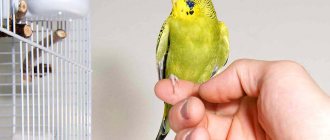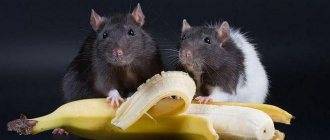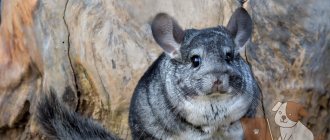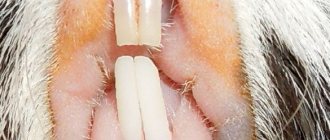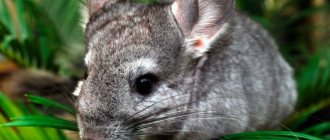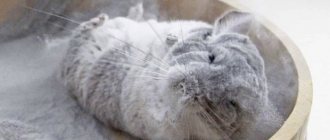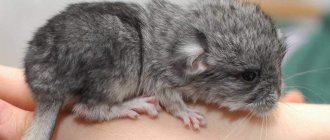Beginning chinchilla breeders are interested in many questions: the behavior of chinchillas at home, their personality traits, and much more. From this article you can learn about your pet’s “bad habits”: do chinchillas bite, how do they sleep, why do they eat their feces, why do they grind their teeth and other interesting facts. It also contains tips for raising chinchillas.
Chinchilla teeth are very sharp
Why do chinchillas bite?
How biting depends on character
The chinchilla bites as a sign of protest when the interests of the pet and the owner collide. This situation can occur if a stubborn animal persistently performs any actions that cause inconvenience to the owner (gnaws furniture, makes a lot of noise) or does not want to play, and the breeder insists on his own.
Chinchilla bites
Some touchy chinchillas show their displeasure by biting. If the owner deprives the animal of a walk or leaves home for several days, the chinchilla will be demonstratively offended - refuse the treat, and not pay attention to the offender. To be bitten, you just have to pick up a rodent in this state of mind.
A timid animal that is afraid of its owner can bite him repeatedly during taming. And the overly sociable person shows sympathy by lightly biting the hands of his household members.
A chinchilla can bite simply out of harm. Animals also have this character trait.
If a breeder wants to find a calm pet that does not show aggression and does not use its teeth, then before purchasing it is worth observing the animal or asking the farmer what type of temperament the individual being purchased belongs to. Chinchillas show their character from childhood, so an easily excitable choleric person or an active sanguine person can be easily distinguished from a calm phlegmatic person and a timid melancholic person.
Aggression
As mentioned earlier, sometimes when rodents get scared or defensive, they will attack. This happens most often with new ones. Bites are usually preceded by squeals, barks, screams, and screams. It may also be preceded by standing on its hind legs, so they appear larger or more vicious than they actually are. When you notice any of these actions, be sure to leave it alone until it cools down.
Find out more Why does a rabbit bite and what to do
Pay attention to where the safe areas are, and do your best not to drive them away from those areas. Besides, let her come to you. They respond to names.
It takes some time (sometimes a year) before the pet gets comfortable. This is especially true for abused chinchillas that have not been properly socialized by breeders. If you know the rodent hasn't had the easiest life, make sure to socialize it very slowly and don't try to touch it for a few weeks.
Let them get used to the new environment, try not to move quickly, make loud sounds, or spray scents around.
Chinchilla bites can be quite serious and may require stitches. If you are bitten, disinfect the wound, apply an antibiotic, and if the bleeding does not stop, consult a doctor.
Reasons why a chinchilla may bite
- Studying the owner. To understand what a particular object is, a chinchilla needs to taste it. This is the nature of rodents, especially for babies.
- Accident. The animal may bite a piece of skin or the owner's finger along with a treat or a sweater sleeve.
- Discontent. Do not disturb the chinchilla while resting or force it to do anything. An irritated animal may bite the offender's finger or other accessible parts of the body. This reaction can occur when another rodent is introduced into the pet’s cage.
- Aggression. If you don’t immediately begin taming your pet, then any intrusion into its territory to pour food or remove garbage will be accompanied by an attack on the “enemy.”
- Revenge. An animal can deliberately bite its owner if he offended him, did not feed him, or does not care for him well.
- Mating season. Overexcited pets may behave inappropriately while protecting their significant other.
Gain trust
To avoid being bitten, take the time to build trust. Place your hand and fingers directly into the cage door and leave it there for a few minutes. Most animals are curious and will eventually come, sniff your hand, and probably bite some part. They will also chew jewelry, nails, and anything else that is above skin level, such as a scar or scab.
Once your chinchilla approaches your hand, try petting or scratching him gently under his chin or along his neck. At first the pet may run further into the cage, but after a short time it will come out again. Gaining trust will take a couple of weeks. Over time, most animals become accustomed to being touched.
Once she becomes more relaxed around you, you can try to pick her up. Some don't mind being handled, others never agree to it. If it is absolutely necessary to pick up the chinchilla, for example to check for injury or to feed it, there will be some struggle if you reach and grab it. However, if good trust has been established in advance, the pet will not show dissatisfaction.
Biting or biting
Chinchilla biting is accompanied by other signs of aggression:
- growling or barking;
- deep dents on the hand;
- sudden movements.
Playful biting goes like this:
- no sounds;
- without pain;
- accompanied by sniffing and playing with fingers.
Let go of your tail or I'll bite you
Affectionate biting is accompanied by other signs of sympathy:
- sniffing;
- "massage";
- can lick with tongue;
- closing your eyes with pleasure;
- puts up its muzzle to be stroked.
Mating sounds
When you have a female and a male living together, sometimes they will mate. The sound when they are both ready for their wedding night is very different from the others and resembles a very soft grunt. With the help of sounds, they call each other to contact and the tone of their sounds can constantly change. The male may also make unpleasant sounds when the female refuses to mate with him.
When you are walking with a pair of chinchillas, without seeing each other, they can use a sound that is a call for a lost partner. The sound is very unusual and from its tone it seems that it is a sound of interest; in itself it is short, but frequent.
During the mating season, in addition to sounds, chinchillas make noise at night because:
- The male clears the floor on himself
- Actively wagging its tail
- Makes sounds when ready to mate
If she runs away from the male, she will make this sound more often, and then it can develop into a sound of discontent. After successful mating, the male makes a strange hoarse sound that can only be compared to hiccups.
How to stop a chinchilla from biting
In most cases, it is enough to take good care of your pet, do not force him to do anything and do not disturb him while he is resting. But first, the animal needs to be tamed:
- more communication;
- give treats from your hands;
- do not bother, do not force games;
- do not go against the will of the pet;
- You shouldn’t grab the animal, let it come into your palm on its own.
To stop a chinchilla from biting, you can use several tricks from experienced chinchilla breeders:
- Move your pet away slightly after the bite and tell him that you can’t do that.
- Lightly click the animal on the nose.
- After a bite, you should not give the rodent a treat.
What to do if you have a severe bite
A chinchilla's teeth are long and quite sharp, so if the animal does not bite your hand for informational purposes, but rather attacks, you can get a serious wound. In most cases, this is safe if you treat the wound in the traditional way - stop the bleeding and disinfect it. Chinchillas almost never become carriers of dangerous infections; even deep bites usually heal quickly. But if the wound hurts a lot, or signs of inflammation appear, it is better to consult a doctor.
IMPORTANT: If a chinchilla bites until it bleeds, this means that the animal is under severe stress, scared or in pain. In such cases, it is better not to try to “wean” it - the pet will not understand the meaning of your actions, it will only be even more frightened.
Source
Other “bad” habits
Most chinchilla habits have a natural origin. Why does a chinchilla eat its own excrement and jump? Because it is so inherent in nature. The structure of their legs is designed for jumping and protection from predators, and due to the droppings, the intestinal activity of the animals is improved.
Falls over on its side
It is rare, but it happens that a chinchilla sleeps on its side simply because this is its favorite comfortable sleeping position.
There are other relatively harmless causes of such “fainting”:
- pregnancy;
- exhaustion and exhaustion;
- overheat.
We sleep as we want!
Rolling onto one side should be a cause for concern if it is accompanied by other symptoms of various pathologies:
- Stroke – aggression, inappropriate behavior, severe thirst, decreased appetite.
- Diseases of the cerebellum - vomiting, decreased chewing function, strabismus, no appetite.
- Rabies - when the animal falls on its side, it twitches.
If your chinchilla has not slept in this position before and if suspicious symptoms appear, you should immediately contact a veterinarian.
Grits his teeth
There can be many reasons for teeth grinding. Most often, the pet simply grinds down its teeth. If, in addition to the fact that the chinchilla grinds its teeth, nothing strange is observed in its behavior, then there is no reason for concern. If you suspect your animal is unwell, it is better to contact a veterinarian.
When the grinding is accompanied by a lack of appetite, it is necessary to check the health of the pet - perhaps he was poisoned by table salt, chemicals or a poisonous plant. In case of poisoning, the following are also observed:
- diarrhea;
- dilated pupils;
- paralysis;
- excessive salivation;
- thirst;
- blue mucous membranes.
Gnaws the cage
- Reasons why a chinchilla chews its cage and how to eliminate them:
- Boredom. It is necessary to give the animal walks, add toys and crawl spaces.
- Natural necessity. Sometimes it is enough to simply place other dental simulators in the cage - tree branches, mineral stones, wooden toys.
- Defensive reaction. If a chinchilla sheds its fur and chews on its cage, it means it wants to free itself. To make your pet friendly, you need to use various taming methods.
When choosing a cage, you must immediately ensure that your pet can chew on it. A cage made of hard wood (beech, etc.) is ideal.
Let me out of here! I want to go for a walk!
Diseases of the genitourinary system and mammary glands
Endometritis
Symptoms
- Lethargy
- Loss of balance
- Collapse
- Dull coat
- No appetite
Treatment
Baytril 0.1 ml and Gamavit 0.7 ml. Subcutaneously 1 time per day. The course of treatment is 7 days.
Then Mastomethrin 0.3 ml and Ovariovit 0.3 ml subcutaneously. The course of treatment is 7 days.
Prevention
Avoid exposure to sun, washing in water, loud noises, rough handling. Do not give dairy products, sweets, eggs, meat or fast food. Do not take the animal outside.
Mastitis
Symptoms
- Breast enlargement
- Restless behavior
Treatment
It's best to see a veterinarian first to make sure there are no abscesses.
Mastometrin injections 1 ml per day, Warming, Massage
Prevention
Prevention here is very difficult to achieve. The cubs can bite the female and damage the mammary glands, resulting in mastitis. The only thing the owner can do is not to abruptly separate the babies from their mother and breastfeeding.
Urolithiasis disease
Symptoms
- Anxiety
- Redness in urine
- Refusal to eat
Treatment
A urine test and ultrasound examination will help determine the presence of stones and sand in the kidneys. If there is sand in the kidneys, antibiotics may be prescribed. If there are stones, then surgery is necessary.
Prevention
This disease can be caused by improper living conditions, stale food or frequent colds. Therefore, the animal must have plenty of water, a suitable cage and food.
Cystitis
Symptoms
- Nervousness
- Frequent urination
- Redness in urine
Treatment
Trimethoprim 20 g 2 times a day and sulfamethoxazole 100 mg 2 times a day.
Prevention
Avoid hypothermia, severe temperature changes, and drafts
Carry out preventative treatment of your home on time
How to put a chinchilla in a cage
Many chinchilla breeders are faced with this problem - the animal does not want to return to the cage after a walk. This may come from mischief or the chinchilla simply does not like her home, perhaps she is lonely and bored there.
Here are several ways to herd the animal into the house:
- Buy or make the cage more spacious and comfortable, add toys, buy a second chinchilla.
- Wait until the chinchilla has walked up and wants to return to the house.
- Training. Command "Home!" and good!" must be combined.
- Do not feed a couple of hours before a walk, but lure him with food after the walk.
Sounds of Anger
In addition to squeaking and grumbling, these animals can signal anger in other ways. This manifests itself in the form of teeth grinding. Moreover, this method is used both by small cubs fighting for a free nipple, and by adults when disagreements arise. When a female and a male are in a quarrel, one provokes the other by gnashing his teeth, and the partner responds with a loud grunt. The situation continues to escalate, the animal shoots urine at the opponent, after which a violent chase usually begins.
Often such quarrels arise when two pets sit together. During such a conflict, you can hear a wide variety of signals, from a dissatisfied grumble to a squeak indicating pain. Sometimes owners should intervene in the situation, as rodents can injure each other.
Behavioral Signs of Stress
Chinchillas are susceptible to stress, which occurs under the influence of external or internal causes. Signs of stress in an animal include decreased appetite, decreased motor activity, avoidance of humans, and gnawing of fur. Learn more about stress factors and fur chewing >>> . Identify and eliminate stressors.
It happens that a wild chinchilla is not easy to handle; it will not bite or shoot urine, but will shed its fur. When you grab the animal, the fur will fall out at the point of contact with your hand. This is their protective natural instinct of “freeing themselves from the clutches of a predator.” Don't worry, the fur will grow back quickly. Try not to grab the chinchilla too harshly, especially not with a sudden movement from above.
